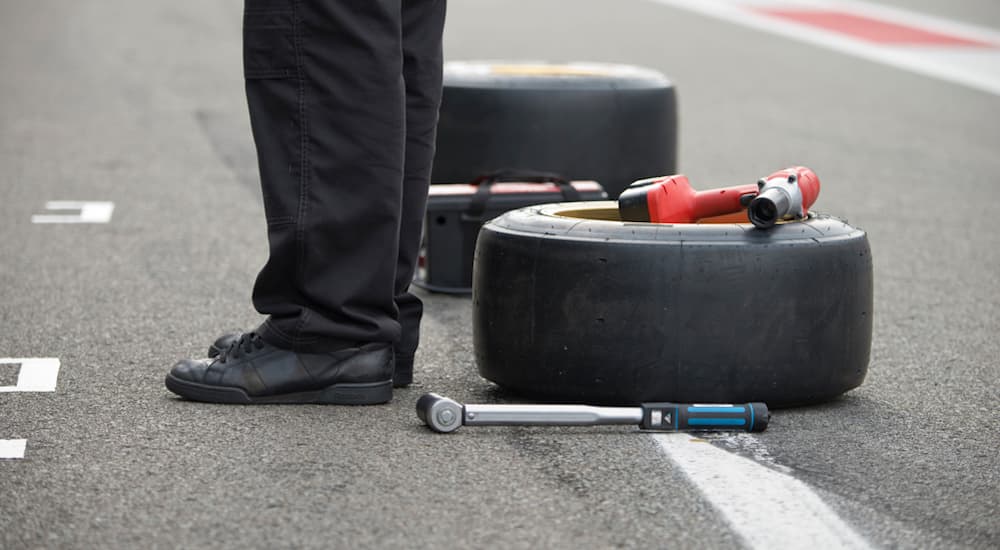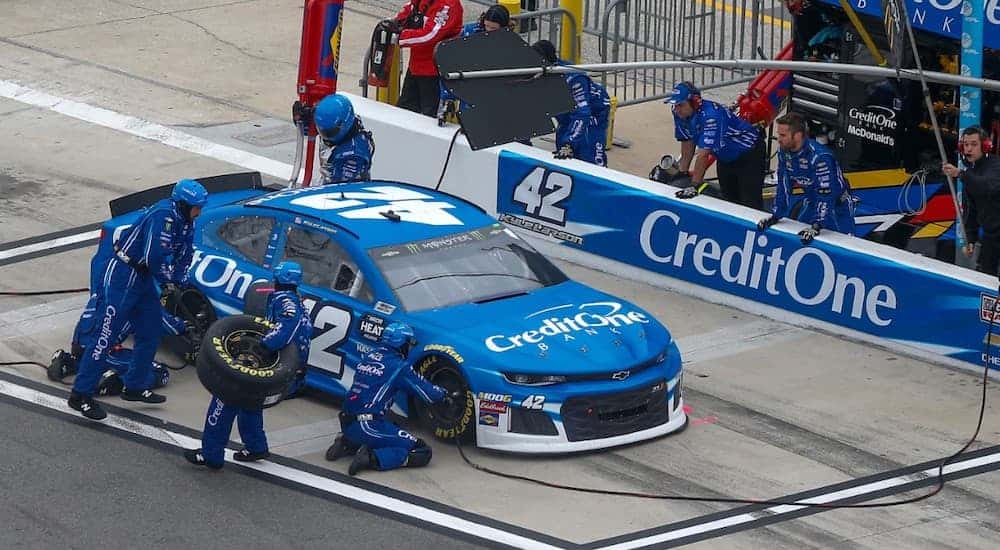Whether you live for NASCAR, enjoy the occasional tailgating trip or a race party at a friend’s house, or you have absolutely no interest in racing, you have probably noticed some differences between the tires on a race car and the ones on your vehicle. Even if you know nothing else about racing, you have certainly seen the occasional clip of a pit crew changing the tires on a car in the blink of an eye. You might think “tires are tires,” but there are some vast differences between race car tires and the discount tires you see at your local big-box store.
Most of these differences come down to the significantly dissimilar conditions in which a race car operates compared to your vehicle. Race cars don’t take the kids to school or go to the store while running errands on a Sunday – they are designed to go around a track for hours at a time at high speeds, and so are their tires. With that in mind, a lot of these differences make total sense and it would actually be weird if they used the same discount tires you do.
#1 – Slick Design (No Tread)
Perhaps the most noticeable and important difference between high-performance racing tires and the discount tires you find at the store is the lack of tread on race car tires. These tires are also referred to as “racing slicks” or “slick tires,” appear like bald tires and lack any tread on them. At first glance, you might assume that this means the tires are very worn down, but in fact, they are designed to be slick and without tread on purpose.
On a dry road, the lack of tread allows these racing slicks to make better contact with the road – there are no grooves to break things up so the entire surface of the tire touches the road. This gives the driver in a race car far better control and handling – more contact means better traction and grip on the road. So, if these slick tires offer better control, why do your tires have big grooves in them?

The answer to that is quite simple: rain. Any bad weather that results in wet roads. At a race track, the driver and team can adjust to any weather conditions and typically drive on roads that are completely dry.
When roads are wet, from rain or melted snow, then a completely slick tire would constantly aquaplane (also known as hydroplaning) and lose control all the time. The deep grooves of the tread on tires are designed to channel water up so that the rest of the tire can maintain contact with the road. Using racing slicks on a wet road would be disastrous, which is why such tires are illegal for general use vehicles.
#2 – Filled with Nitrogen
In most tires, like the discount tires you find at the store or perhaps have on your vehicle, plain air is used to fill them. This compressed air contains a certain amount of moisture in it naturally – you can experience this for yourself with a compressed air canister like you use to clean computer equipment. Spray the air from these canisters for too long or too close to an object and it will become wet from the moisture in the air.
The moisture in compressed air in discount tires will evaporate and expand under intense pressure as heat builds up. Pushing a car to its limits around a race track is a perfect recipe for pressure and heat – so regular air in race car tires would cause them to expand and reduce their performance. Nitrogen is used to fill race car tires, instead of compressed air, because compressed nitrogen has less moisture in it, creating less evaporation and less expansion within the tire as it heats up.
#3 – Second, Inner Tire
Race car tires also have second tires inside the primary tires or racing slicks that you can see when they are going around the track. The discount tires sold in stores and even high-quality all-weather tires are designed with a single outer tire that you see every day. If you are cruising along and your tire blows out, then you will typically have to struggle to maintain control and safely pull over to the side of the road. This isn’t too bad if you’re only going 25mph or even 50mph, but at the high speeds that race cars travel, it would be disastrous.
The inner tire has its own air supply and is mounted separately within the outer tire that you can see. This way, if the outer tire blows out, the inner tire is there to let the driver maintain control and safely reach the side of the track or come to the appropriate pit crew for a stop. NASCAR requires that all racing tires have these inner tires when used on any track that is more than one mile long, due to the high speeds that drivers reach on such tracks.
#4 – Prefixed Lug Nuts

If you’ve ever had to change a tire on your car, then you know that most of the time you spend doing so is in removing and then replacing the lug nuts. These fasten securely onto the bolts of your car’s wheels to keep the tires in place, so they need to be tightened properly and take a while to get on and off. There’s a reason you can’t get discount tires off your vehicle or onto one as quickly as the pit crew at a NASCAR race does.
Part of that is extensive practice – these folks are professionals after all. But part of it is also in the design of the race car tires used at these events. The tires used by race crews actually have the lug nuts already attached to them by an adhesive. The studs on the wheels are longer than on your car and don’t have threading on them, so that they can affix the tires to the wheels, with the lug nuts already on the studs and not have to worry about cross-threading. So the pit crew places the tire onto the vehicle and just has to tighten the lug nuts securely, rather than waste time positioning each one on all four tires.
Something in Common: Radial Design
One thing that race car tires and your standard discount tires actually do have in common, however, is they both use a radial design. In a radial tire or radial-ply tire, the cords within the tire itself are arranged perpendicular to the direction in which the tire travels. In other words, if you look at a tire, then you see it moves forward as it rolls. Within the tire itself are cords that are integral to the strength of your tires – these cords run crosswise at a 90-degree angle to the forward direction that the tires roll.
In the early 20th Century, American tires were made with a bias-ply design where the cords ran at an angle across the inside of the tire, but not at a full 90-degree angle. Radial tires were first developed for commercial use by French manufacturer Michelin and introduced throughout the world. In the latter half of the 1900s, American manufacturers such as Goodyear recognized the superior quality and control offered by the radial-ply design and adopted it for their own tires. Despite all the differences between high-performance race car tires and standard discount tires, at their heart they both share a similar radial design.

